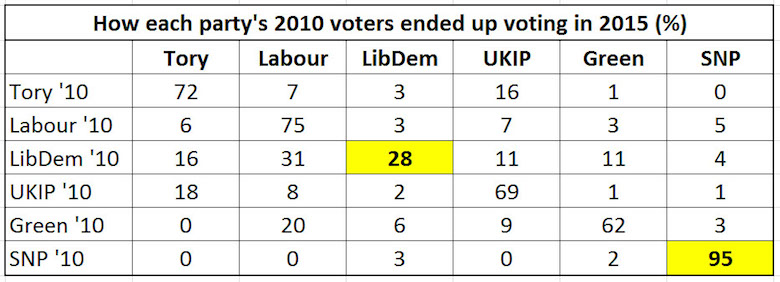Sam Wang unearthed some interesting facts about the recent elections in the UK where the Conservative party surprised everyone by winning an outright majority of 331 seats in the 650—seat parliament. He looked at how people had voted compared to the 2010 elections and compiled this table.
The key fact is that while Conservative and Labour retained the loyalty of roughly three-quarters of their voters, and UKIP and the Greens retained about the-thirds, the outliers were the Liberal Democrats and the Scottish National Party. The former saw massive defections largely to the Labour party while the latter retained an astonishing 95% loyalty. It is clear that aligning themselves with the Conservatives in a coalition government was disastrous for the Liberal Democrats whose overall share of the vote dropped from 23% to just 8%. I don’t know if they can recover.
He also points out that although the SNP got 56 out of the 59 seats they contested in Scotland, they got just 50% of the vote, close to the 45% of the yes votes in last year’s referendum, suggesting that there wasn’t as much of a swing in their favor as had been thought.
The SNP poses a problem for the two major British parties. They both oppose Scottish separation, but if they both contest Scottish seats, it enables the SNP to win by a plurality, thus strengthening the separatist cause. Wang suggests that it may make sense for the Conservatives to not contest those seats and so enable Labour to win a good share of them.
I think that this is unlikely to happen because neither Labour nor Conservative would like to give the impression that they are colluding in this way against the Scots because this might create a major pro-independence backlash.


neither Labour nor Conservative would like to give the impression that they are colluding in this way against the Scots
That was exquisitely phrased, Prof. Singham. I’m sure neither of them would like to give that impression but they’d do it in a heartbeat if they could figure out how to do it without giving the impression of doing it.
I’m not sure I agree with the use of the word “just” there… Going into this election, Scotland had 4 main parties, and an additional 2 minor parties with not-inconsiderable support (although we can probably now consign the Lib Dems to “minor party” status). For a single party to achieve 50% of the vote under those conditions is actually quite remarkable. The last time the overall winner of a UK General Election took more than 50% of the vote was in 1931 (although the Conservatives came pretty close in 1955, with 49.7%), and that’s in a (mostly) 2-party contest.
The overall swing to the SNP was 30%, which (AFAIK) is the largest swing ever recorded in British electoral history.
Dunc,
The ‘just’ was a comparison to the percentage of seats that they contested. You are right that this is a common result in first-past-the-post electoral systems.
Another thing missed in the table is the much higher than usual Scottish turn out.
Some Scottish seats were seeing 70%+ where it was considered a high turnout in England at the mid 50%s.
The SNP did something the English parties failed to and energised hitherto disenfranchised voters by offering something positive.
Fair enough.